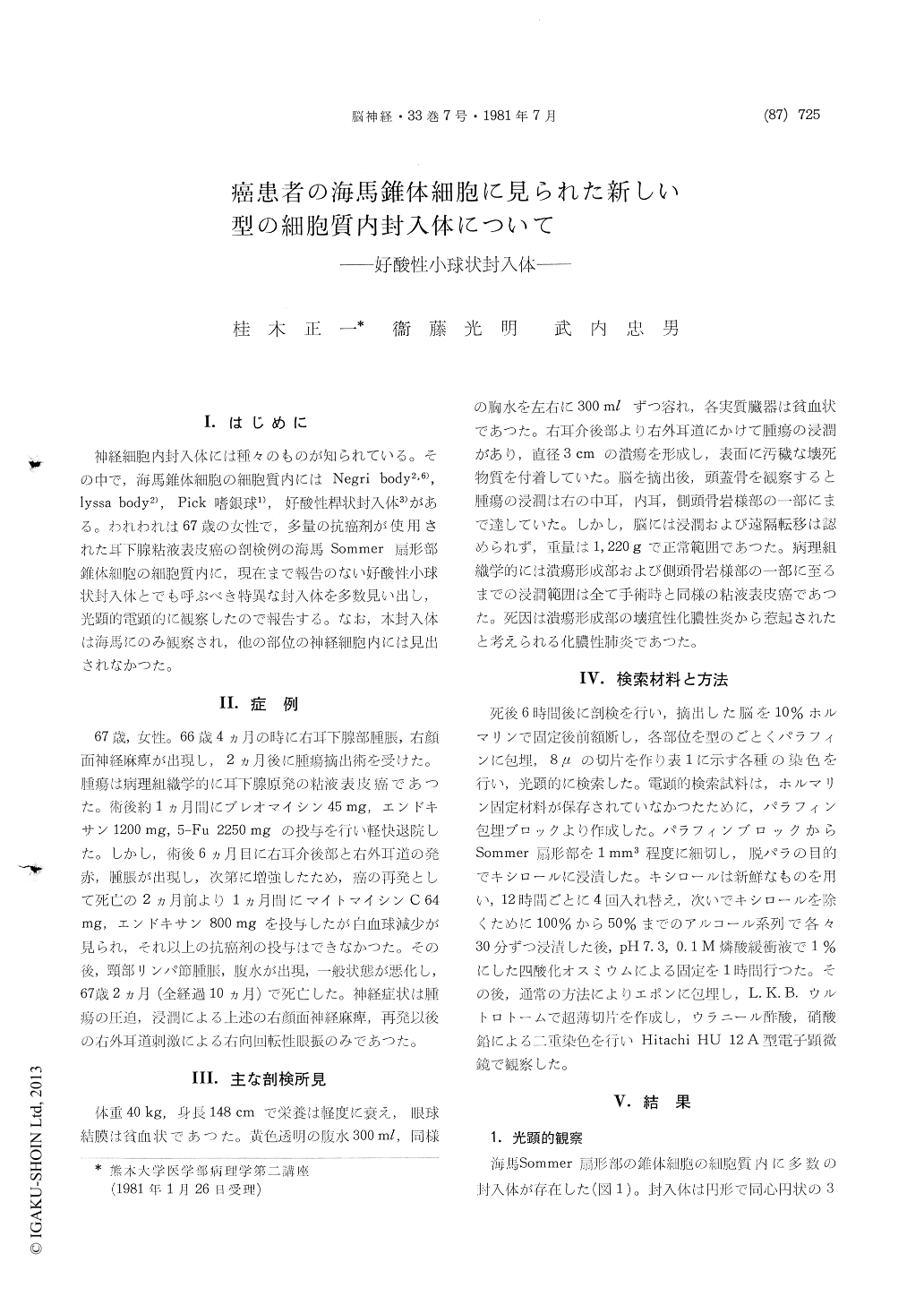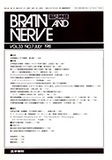Japanese
English
- 有料閲覧
- Abstract 文献概要
- 1ページ目 Look Inside
I.はじめに
神経細胞内封入体には種々のものが知られている。その中で,海馬錐体細胞の細胞質内にはNegri body2,6),lyssa body2),Pick嗜銀球1),好酸性桿状封入体3)がある。われわれは67歳の女性で,多量の抗癌剤が使用された耳下腺粘液表皮癌の剖検例の海馬Sommer扇形部錐体細胞の細胞質内に,現在まで報告のない好酸性小球状封入体とでも呼ぶべき特異な封入体を多数見い出し,光顕的電顕的に観察したので報告する。なお,本封入体は海馬にのみ観察され,他の部位の神経細胞内には見出されなかつた。
The inclusion bodies thus far unknown were detected by light and electron microscopy, in the cytoplasm of pyramidal cells of the hippocampus in the brain of a female autopsy case aged 67, who died 10 months after the development of mucoepidermoid carcinoma in the right parotid gland. The light microscopic examination revealed the presence of inclusion bodies in a round shape, constituted with concentrically circular triple layers, discriminately distinguishable from the innermost 1st layer, to the middle 2nd layer and further to the outermost 3rd layer. The 1st layer was circular, with a diameter of 4.0-5.5μ, sur-rounded by the 2nd layer in a ring shape of 0.4-0.5μ in width, which was further surrounded by the 3rd layer in a ring shape of 0.5-0.8μ in width, which appeared light and shining. The inclusion bodies were considered three-dimensionally to be globules having a diameter of 6.5-7.5μ. These inclusion bodies seemed to exist only in the Sommer's sector of hippocampus, and they were seen individual, in each nerve cell. They were situated mainly in the cytoplasm, in the proximity of the nuclei on the side of apical dendrite, but a few of them were observed to exist also within the dendrites. The 2nd layer was distinguishably stained with eosin and Bodian staining, the 1st layer a little less than the 2nd layer, and the 3rd layer not at all. The other mehods of staining failed to present any characteristic results. By the facts that these inclusion bodies are of globular and that light microscopically, the 2nd layer is stained densely with eosin, it is considered proper to give them the term eosinophilic globular in-clusion bodies. There was, on the other hand, no sign of cellular swelling, or eccentric displacement of nuclei, etc. in the nerve cells having these in-clusion bodies. In addition to these inclusion bodies, the findings of slight neurofibrillary changes, granulovacuolar degeneration, eosinophilic rod-like structure and excessive lipofuscin accumu-lation were obtained by the examination of pyrami-dal cells of the hippocampus.
The electron microscopic examination revealed all three, layers of these inclusion bodies in a filament formation, with differences in the electron-density, diameter and collective density. The 1st layer was composed of filaments 90-140Å in thickness, with a medium electron-density. The 2nd layer was composed of filaments 130-190Å in thickness, with a high electron-density, gathered extremely close together. The filaments forming the 3rd layer extended outwardly from within the 2nd layer, with a medium electron-density, in bundles of approximately 10 filaments running in the same direction, surrounding the 2nd layer. The sizes of the individual filament in this region were irregular, having a range of 130Å in fine parts to 270Å in thick parts, with medium thickness also evident. The constituents of these filaments are as yet unknown. Furthermore the mechanism of these inclusion formation is also unknown, however the change in the nerve cell metabolism, due to the massive administration of anti-cancer drugs (45mg of bleomycin, 2000mg of endoxam, 2250mg of 5-Fu and 64mg of mitomycin), can be presumed to have a close association with this formation.

Copyright © 1981, Igaku-Shoin Ltd. All rights reserved.


